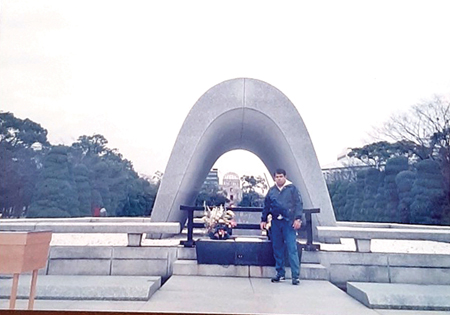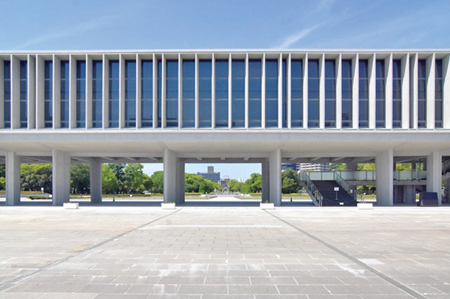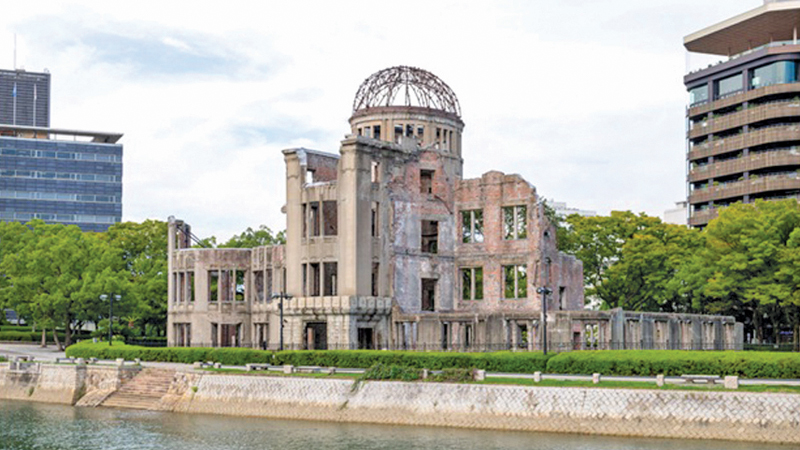Seventy-nine years ago, on August 6, 1945, an American atomic bomb reduced Hiroshima to ashes, devastating not only physical structures but also countless lives. Having been affiliated with Hiroshima Economics University 30 years ago, I spent a year and a half in the city, often visiting the poignant landmarks of Hiroshima Peace Park: the Peace Memorial Museum, the haunting Atomic Bomb Dome, the solemn Cenotaph for the Atomic Bomb Victims, the Children’s Peace Monument, the eternal Peace Flame, the resonant Peace Bells, and the informative Peace Memorial Library.
During my time there, I extensively researched and penned articles detailing the profound impact of the Hiroshima atomic bomb, which were later published in newspapers in Sri Lanka. As Japan commemorates the victims of that tragic day this week, I reflect on my experiences and the notes I gathered, aiming to weave together a narrative that honours their memory.
Conflict in the Pacific began well before the official start of World War II. Seeking raw materials to fuel its growing industries, Japan invaded the Chinese province of Manchuria in 1931. By 1937, Japan controlled large sections of China, and accusations of war crimes against the Chinese people became commonplace. Several treaties were in place to limit the size of navies in the Pacific Ocean. In 1934, Japan ended its cooperation with other major powers in the Pacific by withdrawing from the Five Power Treaty. The United States, along with other countries, criticised Japanese aggression but shied away from any economic or military punishments.
Bombing on Pearl Harbour
The Japanese bombing of Pearl Harbour on December 7, 1941, brought the United States officially into World War II. In the surprise attack, Japan sunk several ships, destroyed hundreds of planes, and ended thousands of lives. The Japanese goal was to cripple the US Pacific fleet, and they nearly succeeded. President Franklin Roosevelt called the attack “a day which will live in infamy,” and the American people were shocked and angered.

The writer of this article standing in front of the Cenotaph, Hiroshima Peace Park
Upon becoming President, Harry Truman learned of the Manhattan Project, a secret scientific effort to create an atomic bomb. After a successful test of the weapon, Truman issued the Potsdam Declaration, demanding the unconditional surrender of the Japanese Government and warning of “prompt and utter destruction.” However, there was no response from the Japanese side.
On August 6, 1945, the United States dropped an atomic bomb on the city of Hiroshima. The bomb, known as “Little Boy,” was a uranium gun-type bomb that exploded with about 13 kilotons of force.
At the time of the bombing, Hiroshima was home to 280,000-290,000 civilians as well as 43,000 soldiers. Between 90,000 and 166,000 people are believed to have died from the bomb in the four-month period following the explosion. The US Department of Energy has estimated that after five years, there were perhaps 200,000 or more fatalities as a result of the bombing, while the city of Hiroshima has estimated that 237,000 people were killed directly or indirectly by the bomb’s effects, including burns, radiation sickness, and cancer. The city of Hiroshima was annihilated by the explosion. Seventy-thousand of 76,000 buildings were damaged or destroyed, and 48,000 of those were entirely razed. Survivors recalled the indescribable and incredible experience of seeing that the city had ceased to exist.
The bomb was dropped on Hiroshima at 8.15 a.m. from a specially designed aircraft known as Enola Gay, a Boeing B-29 Super fortress bomber. The pilot chosen for this operation was Colonel Paul Tibbets, the commander of the 509th Composite Group. “Little Boy” is the name of the atomic bomb.
Little Boy
At 8:16:02 a.m., after falling from the Enola Gay for 43 seconds, the Little Boy atomic bomb detonated 1,968 feet above Hiroshima, 550 feet from the Aioi Bridge. Nuclear fission began in 0.15 microseconds. At 8:16:03 a.m., one second after detonation, the fireball reached its maximum size of 900 feet in diametre. The mushroom cloud began to form. As temperatures on the ground reached 7,000 degrees Fahrenheit (3,871 Celsius), buildings melted and fused together, and humans and animals were vaporised. The blast wave travelled at 984 miles per hour (1,583.59 kph) in all directions, demolishing over two-thirds of Hiroshima’s buildings in a massive expanding firestorm. Eighty thousand people were instantly killed or grievously wounded. Over 100,000 more would die from the bomb’s effects in the coming months.
Three days later, just after 11 a.m. on August 9, a second atomic bomb, nicknamed “Fat Man,” exploded above the city of Nagasaki. Although it was even more powerful than “Little Boy,” the destruction caused by this bomb was less than at Hiroshima due to the nature of the terrain. Nonetheless, over 2 square miles of the city were pulverised, and some 73,000 people were killed.

The Hiroshima Peace Memorial Museum. hiroshimaforpeace.com
At noon on August 15, 1945 (Japanese time), Emperor Hirohito announced his country’s surrender in a radio broadcast. The news spread quickly, and “Victory in Japan” or “V-J Day” celebrations broke out across the United States and other Allied nations. The formal surrender agreement was signed on September 2 aboard the U.S. battleship Missouri, anchored in Tokyo Bay.
The San Francisco Peace Treaty, signed by 48 nations on September 8, 1951, officially ended Japan’s position as an imperial power, provided compensation to those who had suffered in Japan during the Second World War, and terminated the Allied post-war occupation of Japan. The treaty’s seven chapters and preamble marked the end of hostilities between the signatories and provided the foundation for the strong US -Japan political alliance and important bilateral military relationship still in place today. The treaty required Japan to give up all special rights and privileges in China and accept the decisions of the International Military Tribunal for the Far East (IMTFE). Japan relinquished its claim to Korea, Formosa, and other territories and gave the US control of the Ryukyu Islands (Okinawa).
Anniversary of bombing
Every year, on the anniversary of the bombing, a ceremony is held at the Hiroshima Peace Park. Speeches are made, wreaths are laid at the Cenotaph, and a moment of silence is observed at 8.15 a.m., the precise moment of detonation. The Peace Memorial Ceremony is held each year in memory of the victims of the atomic bomb and also to perpetuate the memory of nuclear horrors and advocate for world peace at Hiroshima Peace Park.
I had the opportunity to attend one of these events while I was living there. This year’s ceremony is scheduled for Tuesday, August 6, 2024, beginning at 8.00 a.m. and ending at 8.50 a.m. The unique feature of this program is that the ceremony takes only 50 minutes. The major events include two speeches, the Dedication of the Register of the Names of the Fallen Atomic Bomb Victims, the Dedication of Flowers, Silent Prayer and the Ringing of the Peace Bell, the Peace Declaration, the Release of Doves, Commitment to Peace, and the singing of the Hiroshima Peace Song.
This article would be incomplete without describing the Hiroshima Peace Park. The Peace Park is located at the epicentre of the atomic bomb in a land area of 120,000 square metres. It is dedicated to the legacy of Hiroshima as the first city in the world to suffer a nuclear attack at the end of World War II and to the memories of the bomb’s direct and indirect victims. It is estimated that one million people visit this location each year. It was planned and designed by the Japanese architect KenzoTange.
The prominent components of Peace Park are the Peace Memorial Museum, the haunting Atomic Bomb Dome, the solemn Cenotaph for the Atomic Bomb Victims, the Children’s Peace Monument, the eternal Peace Flame, and the resonant Peace Bells.
Atomic Bomb Dome
The Atomic Bomb Dome is what remains of the former Prefectural Industrial Promotion Hall. When the bomb exploded, it was one of the few buildings to remain standing and remains so today. A UNESCO World Heritage Site, the A-Bomb Dome is a tangible link to Hiroshima’s unique past. The Hiroshima Peace Memorial (Genbaku Dome) was the only structure left standing near the hypocenter where the first atomic bomb exploded on August 6, 1945.
Through the efforts of many people, including those of the city of Hiroshima, it has been preserved in the same state as immediately after the bombing. Not only is it a stark and powerful symbol of the most destructive force ever created by humankind, but it also expresses the hope for world peace and the ultimate elimination of all nuclear weapons. The city of Hiroshima decided in 1966 to preserve the dome indefinitely.
Between the Museum and the Atomic Bomb Dome is the Cenotaph for the Atomic Bomb Victims. The Cenotaph is an arched tomb for those who died because of the bomb, either because of the initial blast or exposure to radiation. Below the arch is a stone chest holding a register of these names, of which there are over 220,000. The Cenotaph’s shape resembles an ancient clay house that helps shelter the souls of the victims from rain. The stone base houses a registry of the names of over 300,000 people who lost their lives during and after the bombing.
Peace Bell
The Peace Bell was created with the hope of abolishing nuclear weapons and achieving world peace. Created by bell-caster Masahiko Katori (considered a living National Treasure), the bell is embossed with a singular unified world map without borders—symbolising an interconnected globe at peace. The surrounding pond contains lotus flowers that come to bloom around early August. Visitors are encouraged to ring the bell as they pray for world peace.
First lit in 1964 in the hope of a world without nuclear weapons, the flame continues to burn until they are abolished around the world. The pedestal that cradles the flame evokes the image of two hands joined at the base, palms facing the sky.
The park’s main facility is the Peace Memorial Museum. Consisting of two buildings, the museum surveys the history of Hiroshima and the advent of the nuclear bomb. Its main focus, though, is on the events of August 6: the dropping of the bomb and its outcome in human suffering. The personal details displayed are quite upsetting and serve to remind us that we should not take peace for granted. The Hiroshima Peace Memorial Museum offers a definitive collection of exhibits on the atomic bombing, spanning this vast complex.
Starting on the third floor in the East Building, visitors exploring the permanent exhibition are presented with four distinct sections dedicated to the history of Hiroshima and the dangers of nuclear weapons. Featuring belongings from victims alongside historical photography and video footage, visitors can rent English audio guides to ensure they receive the full explanation of each exhibit. The Hiroshima Peace Memorial Museum also frequently presents special exhibitions and events that discuss the bombing from different perspectives.
Peace Memorial Hall
One of the more recent additions to the Hiroshima Peace Memorial Park is the Hiroshima National Peace Memorial Hall. Designed by KenzoTange and opened in 2002, this impressive architectural space is dedicated to victims of the atomic bomb through the personal accounts of survivors sharing their message with future generations. Alongside names and portraits, the library section presents memoirs, testimonial videos, and photographs that capture people’s most intimate memories of the event. Here you’ll also find a large-scale image depicting the city following the blast, plus the remembrance hall provides a space for quiet reflection.
The Children’s Peace Monument was built to commemorate Sadako Sasaki and the thousands of child victims from the atomic bombing of Hiroshima. Sadako Sasaki was a young girl who was exposed to radiation from the atomic bomb blast, dying ten years later after a long battle with leukaemia. Before she passed away, Sadako had a vision to create one thousand cranes—which she achieved—echoing the Japanese tradition that granted one wish upon doing so. Sadako’s wish was for a world without nuclear weapons, and the paper cranes seen here serve as a reminder of this. The park’s memorials present the city’s message from several viewpoints, including children.
While the atomic blast killed about 135,000 people, the effects of radiation poisoning and other medical conditions caused many more deaths and illnesses. One of these victims was a young girl called Sadako Sasaki, who died from leukaemia a decade after the explosion.
The writer is Senior Lecturer, School of Business and Public Policy, the University of Papua New Guinea.







